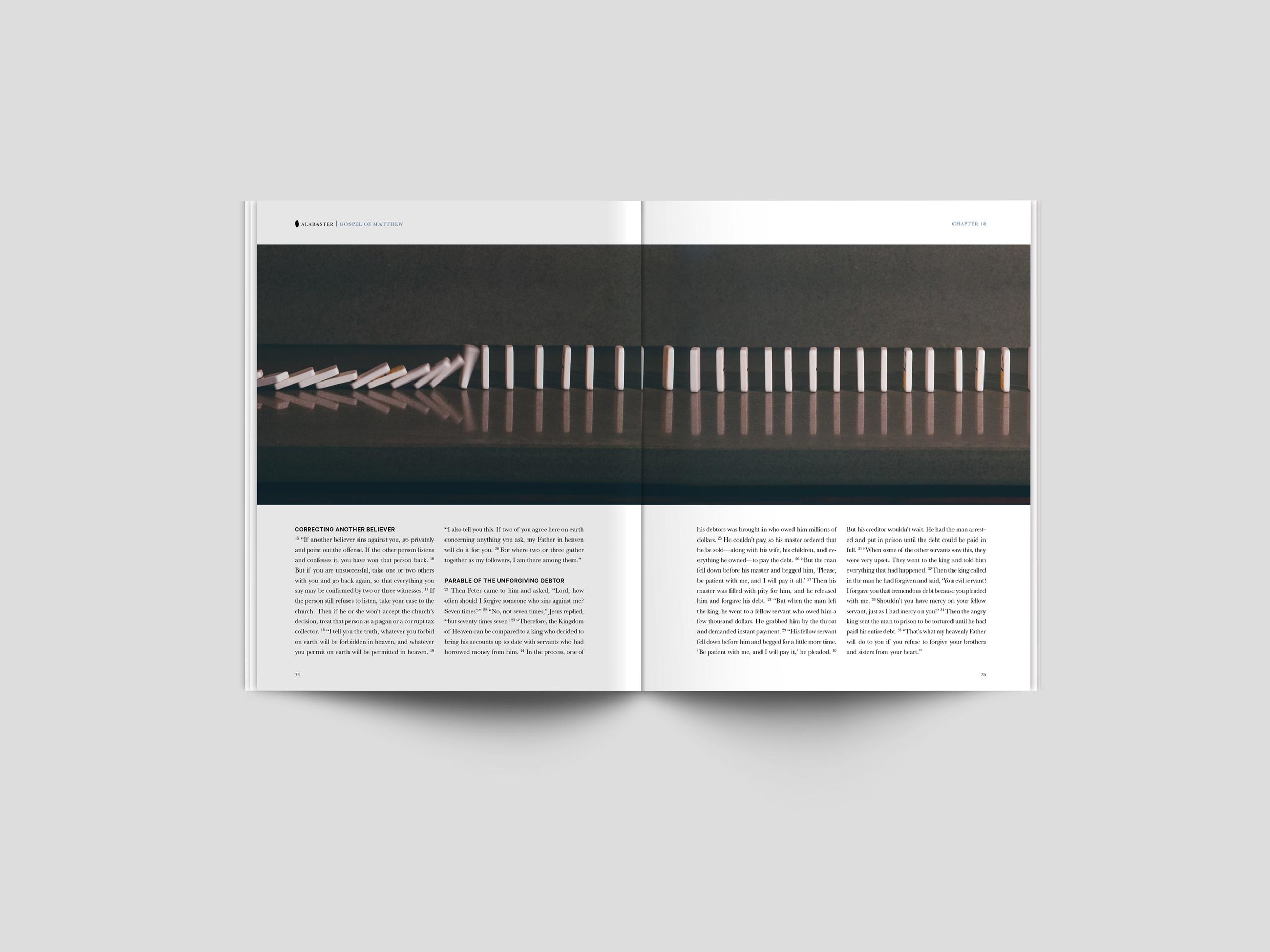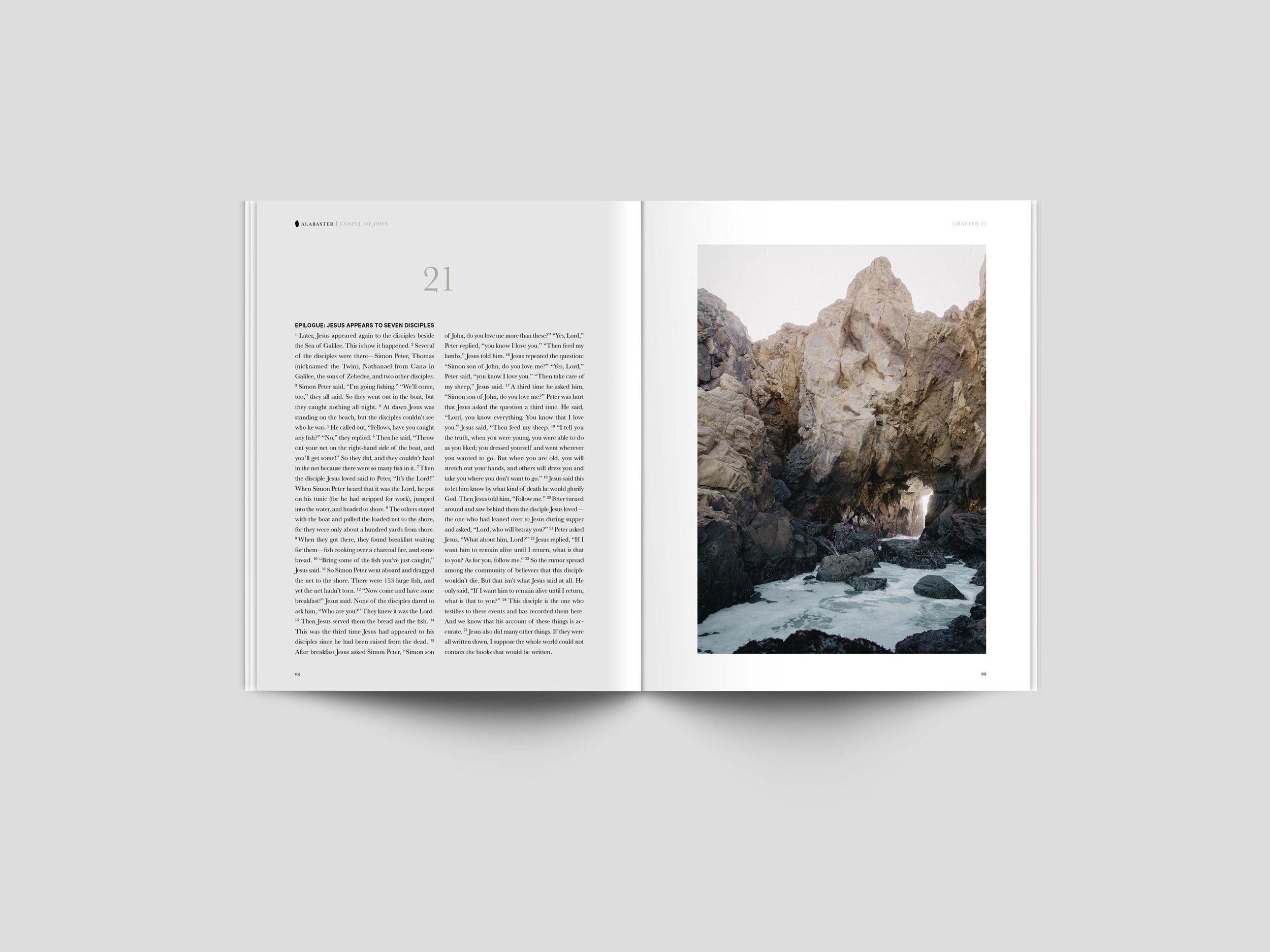Interview With Alabaster Co.
"The Bible by itself is already beautiful. But we wanted to create a way in which the reading experience of the Bible was beautiful as well."
An interview with Bryan Chung and Brian Chung (who, despite the last name, are not actually related), photographers behind the Alabaster Bible, exquisitely designed editions of the Gospels.
What first drew you personally to the field of visual communication?
BRIAN: I was drawn to the ability for design to take these chaotic and disparate ideas/objects and bring them together in a meaningful way. To me, that's what makes design so powerful. It can communicate complex things that otherwise wouldn't be understood clearly.
BRYAN: My earliest memory is actually of creating this large painting on butcher paper when I was two years old. It wasn't anything specific, just random paint strokes haphazardly placed about. But it was the "physical" act of creating that first drew me in — where my hands, my mind, and my heart all felt in sync in making this painting I could see in front of me.
How did Alabaster Co. get started? What was the initial spark, and how did that lead to your current mission as a company?
BRYAN: We were both strongly influenced by a mentor named James Choung, who wrote a book called Real Life. In it he has an idea about how each generation chooses to ask a "Spiritual Question,” directed towards finding meaning and purpose. In the past these questions have been things like: what is true? What is real? What is good? And in the book Choung predicts that the next spiritual question people will be asking is: what is beautiful? We're becoming a culture primarily focused on visual content. We look at websites, scroll through Instagram, and appreciate well-put-together books. And we judge these things not purely on the content, but on how excellent it is and how well it is designed.
Further, I'd say larger culture is not asking what is the correct thing to worship, but rather, what is worth worshipping? What is beautiful and worthy of worship? And in the midst of that spiritual question, I think we're asking: how do we show that the Gospel is beautiful? So we wanted to start Alabaster to be a part of that emerging conversation between creativity, beauty, and faith.
BRIAN: The Bible by itself is already beautiful. But we wanted to create a way in which the reading experience of the Bible was beautiful as well. I did not grow up Christian and when I got my first Bible, I was excited but also found it intimidating. I found myself asking, "Where do I start?"
Fast forward, and I was a campus minister at a conference for people who don't consider themselves Christian to explore Christianity. Everyone got a Bible, and I watched how a non-Christian opened it. She began at the front, where the first few pages were lengthy descriptions and maps. She literally had to flip many different very thin pages to finally get to the first page of Genesis. Upon reaching that page she closed the book and put it away.
In re-designing the Gospels, our aim was to change the way people experience Scripture. There is something about thoughtful images and beauty that help us engage in deeper ways. We were curious to see what that would look like within the biblical text.
"Larger culture is not asking what is the correct thing to worship, but rather, what is worth worshipping?"
"There's something about art and beauty that helps us feel safe in engaging in difficult/taboo topics, because it hits us on a very human level."
You're really passionate about engaging with an increasingly visual culture. What are some of the primary goals you have as photographers, and what do you think are the primary strengths of visuals as a unique mode of communicating truth?
BRIAN: There's some truth in that saying, "a picture is worth a thousand words.” Through visual mediums I believe you're able to communicate a level of complexity that sometimes just cannot be reached otherwise. It helps people engage in new ways and experience new insights.
BRYAN: When an artist makes a piece of art, that art is literally a part of who they are. There's an honesty that naturally comes forth whenever someone makes art. Honesty connects us and touches us on a human level. When that honesty merges with the biblical text, I believe it creates something really special.
What do you think are the pitfalls of a visually oriented culture, or specific areas you think present opportunities for growth and innovation?
BRYAN: The danger of course is that visuals replace words entirely. Just as visual artworks can communicate things that words cannot touch, words can communicate things that visuals cannot touch. Words are still the primary means of daily communication. The reality is that we need both words and visuals to compliment each other. That's why in the art world, you not only see the artist, but also the critic. They balance and build off each other, and together offer something truly enriching in culture.
What do you hope people get out of the Alabaster Gospels?
BRIAN: Our hope is that the design and the imagery of Alabaster help readers engage with the biblical text in a new way. Visual artworks open up people to new possibilities, so we hope the books create new conversations for people within the Gospels. And, as our generation becomes more and more visual, we also hope it challenges people to consider beauty as an important and necessary value within the kingdom of God.
There's also something about art and beauty that helps us feel safe in engaging in difficult/taboo topics — regardless of spiritual background — because it hits us on a very human level. Especially for those who might not consider themselves Christians, we hope the books create a safe place to have conversations about God.
"Honesty connects us and touches us on a human level. When that honesty merges with the biblical text, I believe it creates something really special."
"Great art has truth to it, but it also challenges the viewer to respond or question in some way."
Are there any specific photographers/influences/styles that you draw on for your work?
BRIAN: We're strongly influenced by Makoto Fujimura, who is the preeminent figure on visual theology. We also have friends at Cereal Magazine who influence and challenge us to make the best images possible. And we're influenced by the aesthetic that comes out of Art Center College of Design. We all have ties to that school and our lead designer (Josephine Law) was a student there.
What were some of the challenges and breakthroughs you've experienced in seeking to communicate the Gospels visually?
BRYAN: With all visual artworks, the challenge is that sometimes the viewer does not "understand" what the work means. We found ourselves constantly trying to strike a balance between easily digestible imagery and images that could still be open-ended for the viewer to interpret. Great art has truth to it, but it also challenges the viewer to respond or question in some way. So — some of the images you'll "get" right away. Others you'll want to sit with, think about, and interpret for yourself. And in that contemplation is when real breakthrough comes forth.
What do you hope to accomplish in the future, and what are you looking forward to?
BRYAN: We hope to be a part of the emerging conversation between creativity, beauty, and faith. As our culture pushes towards the visual and becomes focused on questions of beauty, we ultimately believe that the conversation can lead to a more beautiful human flourishing. We're excited by that. We've got plans to re-design other books of the Bible. And we realize the conversation does not end there, but continues through the lives of real makers/doers. So we've also begun Alabaster: The Journal, where we're passionate about interviewing those creatives and making more original artistic content.








